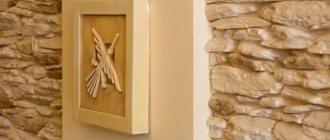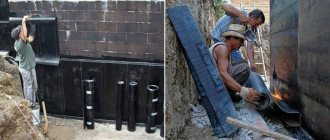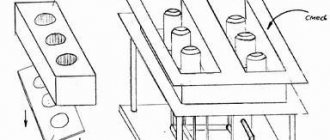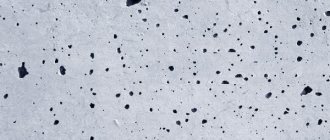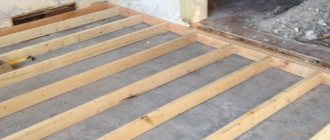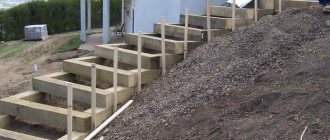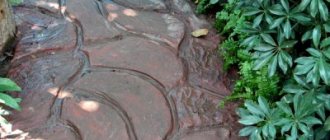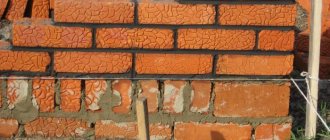What are facade tiles and their varieties
Many people doubt whether this entire process can be carried out without special equipment and how durable the material will be. Therefore, before you start making facing products yourself, you need to study what tiles are and how they are made in production.
There are several main types of tiles based on the main component:
- concrete - made of cement, sand and plasticizers;
- ceramic - made from special grades of clay and fired in ovens at high temperatures;
- clinker - high-quality types of clay are pressed under high pressure and fired at a temperature of about 1200 degrees;
- porcelain stoneware - made like clinker, but granite chips are added to the composition;
- terracotta - made from porous clay of the same name.
Each type corresponds to the manufacturing method and the main filler, which gives the material aesthetics and protective properties. Tile products can be divided according to shape:
- finishing facade stone;
- clinker brick;
- imitation of finishing or masonry brick;
- flat rectangular tiles with a smooth, rough, matte or glossy surface.
Manufacturing processes can be: firing or dry pressing. Conventional ceramics go the following way:
- Extraction of raw materials in quarries.
- Processing of material, its cleaning.
- Formation;
- Drying;
- Burning.
For concrete products and for many types of artificial stones, the process is limited to vibration casting and drying.
Let's compare what equipment is used in production and what can be used to replace it at home.
- The crusher and extrusion machine can be replaced with a ready-made mixture from a hardware store.
- A concrete mixer will completely replace a mini concrete mixer or a bucket and a drill with an attachment.
- A vibratory casting press will replace a vibrating table.
- You can make press molds yourself or purchase them in a store.
As you can see, the whole process is easy to repeat at home. Some will ask why this is needed, because the required material can be bought for a suitable amount. But here’s an example: you have a design in mind, but a suitable stone is not on sale, or is available, but the color is not suitable. And it may also be too expensive. In the end, this type of cladding may not exist at all. That's when your own hands and useful advice come to the rescue.
Production premises and equipment
To make paving slabs at home you need:
- room from 12m2;
- concrete mixer;
- vibrating table;
- auxiliary tool;
- forms;
- Consumables.
A garage, barn, or any building with walls and a roof is suitable as a room. It is important that the room is equipped with high-quality wiring for connecting electrical appliances. Indoors, along the walls, you need to make reliable racks for drying finished products. The recommended shelving area is 20 m2.
For production you will need two main units - a concrete mixer and a vibrating table. A concrete mixer is suitable for both a forced type and a regular pear. Typically, in home production, household concrete mixers operating on a 220 volt network are used. The recommended stirrer volume is from 180 liters. A forced-type concrete mixer is suitable only with a low shaft speed: from 16 to 24 revolutions per minute.
Forced type concrete mixer
A vibration table will suit absolutely anyone. The main function of the vibrating table is to shake the solution in the mold. Its cost on the secondary market starts from 5,000 rubles. If you have welding equipment, you can make a vibrating table yourself. To do this, you need a corner or pipe, a sheet of metal, springs, and an electric motor.
Electric motors can be used both specialized ones, which are made for vibration equipment, and household ones, used for sharpening knives. The main thing is that the engine speed is from 1800 to 3000 per minute.
Vibrating table
The following auxiliary equipment will be needed: shovels, trowels, buckets, a trough, a container for water and plasticizer, large and small scales, a hair dryer. To dry the tiles, you will need a cellophane film with an area of 6–10 m2.
Mold making
Today it is quite possible to purchase ready-made forms. They come in all types of tiles; if you look hard enough, you’ll be lucky enough to buy exactly what you need. The most important thing is not to purchase cheap plastic matrices. Usually they are enough for no more than one application of the solution, after which the plastic becomes unusable. As already noted, a suitable form may not be on sale, then you will inevitably have to make it yourself. Whatever material you choose for the matrix, you can take an artificial analogue, tile or natural stone as a basis. If you choose the second option, then buy several different samples, remember that nothing is the same in nature. The base can be a wooden beam or log. The main thing is to choose a beautiful wood texture. Let's understand the technology of the form.
Let us immediately note that the base can be made for one tile or directly for a group of stones. It is more profitable to do the second one, since the output is several finished products at once, and the speed of work, accordingly, increases. Whatever material you use, you will need formwork. Buy ready-made or make it yourself.
Silicone
Silicone is sold in different packaging. It’s better for you to look in buckets, since in tubes you will overpay for packaging, but you need a lot of it.
Now we lubricate the bottom and walls of the formwork with a special lubricant, and lay tiles or stones on the bottom. The sources also need to be lubricated, since they will have to be freed from silicone.
Important! If gypsum stone or tiles are used as the starting material, then they must be covered with several layers of varnish, only then coated.
Prepare a soap solution for brushes and spatula. Apply silicone and smooth it with a brush, constantly pressing. This way you will avoid bubbles. Now it is advisable to compact the silicone and level it with a soap spatula. Now the mold must be left until the silicone hardens.
The polymerization process takes a long time. The standard rate is 2mm per day. The thicker the future workpiece, the more time it will take. Don’t rush to pull out the matrix; the stronger it is, the longer it can be used. A poorly polymerized form can be used once or twice. Standard properties of silicone sealant that should be taken into account when working:
- tensile strength - 01 MPa;
- density - 1200 kg/m3;
- viability - 8 hours;
- durability - 20 years.
After complete hardening, the material is removed, the matrix is washed with soap and can be used.
Compound molding dies
There are special compositions for casting molds. They can be purchased at construction stores or craft departments. There is no need to chase imported compounds; our compounds are of good quality and reasonable cost.
The example shown in the photo has two components. Silagerm -5035 has a tensile strength of about 4 MPa, shrinkage of no more than 1%, and a complete hardening time of 24 hours.
Selecting forms
It is important to understand that the factory technology for manufacturing facade tiles is not suitable for home use. The only thing that can be introduced is the vibration casting method. As for the forms, the cost of a quality product is high.
The purchasing decision depends on the scope of work. One high-quality mold is designed for up to 1500 tile production cycles. If you need to produce up to 20 squares of tiles, then buying an expensive mold will not justify the investment. In this case, it is better to do it yourself. Therefore, it is important to make the correct calculations.
Important! It is not always possible to make a mold at home so that the tiles turn out to be of high quality, which will affect the aesthetics of the final result.
Therefore, if you do not have the ability and opportunity to make a high-quality mold with your own hands, it is better to purchase it.
Professional production of tile material at home
Do-it-yourself tiles are made using gypsum or cement. Gypsum cladding is usually used indoors, but if its surface is impregnated with hydrophobic substances, it can be used on building facades in dry climates. Nevertheless, many are interested in gypsum products, since they are easier to give the required color, they have better adhesion and are much lighter than cement elements.
Production of gypsum-based facing elements
To work you will need the following tools and materials:
- Plaster, preferably white.
- River purified sand.
- Lemon powder.
- Necessary dyes.
- PVA glue.
- Drill with mixing attachment.
- Matrices for shaping.
- Plastic bucket for solution.
- Brushes and spatula.
Before work, prepare a place to dry the material. It must be perfectly even so that the products are of the same thickness. Let's look at the whole process step by step.
- Add 1.5 kg of gypsum to one liter of water and mix with a mixer attachment. Please note that it is in this sequence, and not vice versa: first water, then plaster.
- Sand gives strength to the finished finish and should have a particle size of up to 1 mm. You can use smaller fractions, it all depends on the type of finished product. Sand is added in the proportion of 100 grams of sand per 1 kg of gypsum powder. Everything gets mixed up again.
- If you do not want your gypsum mass to harden after 5 minutes, and it has just such a setting period, then add citric acid to the solution.
- PVA glue will serve as a plasticizer for the mass; it, like lemon, delays the hardening of the mass. After adding PVA and powder dye, the mass is mixed again. It should reach the consistency and thickness of sour cream.
- Before mixing, you need to prepare the mold. Silicone is coated with any lubricant, for example a mixture of turpentine and wax. The polyurethane matrix must be lubricated with a special release fluid.
- If you are making tiles to look like stone, then it is worth touching up the bottom of the mold in some places. This will make the stone tiles look more natural.
- The mass is poured into molds in parts. The first portion is shaking, the second portion is shaking. The presence of a vibrating table would be desirable and working with it would be much easier, but you can do it this way. Shaking is necessary to distribute the mixture evenly. When you apply the top layer, it will already have thickened, and therefore you need to do all the work quickly.
Video instructions for making tile elements from gypsum mortar
We invite you to watch a detailed video tutorial. After watching it, you will learn how to cast beautiful finishes for your home without difficulty.
Cement paste tiles
Cement or concrete tiles and artificial stones are much more in demand, as they can be used on any facades, garden paths and other types of landscape design. Nothing will happen to them in any weather. This tile is resistant to weathering, chemical and biological influences. It is durable and wear-resistant. Such products can be formed from Portland cement, river sand and water. PVA glue is added as a plasticizer. The following is all familiar:
- Cement and sand are mixed in powder at a ratio of 3 to 1. Then water and glue are added to them. The mass is mixed well with a concrete mixer or drill with an attachment.
Useful tips for installing tiles yourself
To avoid mistakes during installation, we will give some recommendations that will help make the cladding process better and faster.
- Any finishing with tiles or stone should be carried out at a temperature from +5 to +25 degrees. The weather should be dry, but not hot.
- The surface of the walls must be carefully prepared. Often the durability of the masonry depends on this. Remove the old finish, prime and, if necessary, plaster the working walls.
- Do not lay facing material on wet plaster or on a new, unsettled façade.
- The masonry can be jointed or seamless. If you have made “bricks” or rectangular tiles, then you can use special calibrators, then the seams will be the same.
Making cladding yourself is a fascinating process; in addition, it is good for the wallet and will satisfy any needs and imagination. Don’t rush to buy ready-made finishing materials; perhaps you will end up with exclusive forms of facade tiles like in the photo, and even with your own hands.
Manufacturing process
Work should be carried out at temperatures from +15 to +30 degrees Celsius, this range is ideal for hardening. Operations are performed in the following sequence:
- The molds are lubricated with oil or soap, this will help you easily remove the finished products from them.
- All components are mixed in a container and filled with water, using a mixer or concrete mixer to obtain a homogeneous mass. The resulting composition should be dense and plastic in structure.
- Dye is added to the solution and everything is mixed again.
- The mixture is evenly distributed among the cells; this must be done on a vibrating table that is turned on.
- Using a spatula, the concrete is leveled in the molds to a single level, and the excess is removed.
- The blanks are sent to a drying cabinet or covered with polyethylene and left for several days.
- Matrices with hardened products are immersed in warm water for a couple of minutes, after which the finished product is removed.
Based on materials from https://www.formpark.ru/.
Do-it-yourself technology for making molds for facade tiles and artificial stone
Tiles are a universal material with which you can beautifully and reliably decorate your home, both inside and outside.
Some people order tiles from special catalogs, paying for the services of installation specialists, while others prefer to try themselves in the field of not only a layer, but also a craftsman in the manufacture of tiles and decorative stones of the desired size, color and structure.
To obtain high-quality facade tiles or stone, you will need to use special forms. Again, there are two options here: buy ready-made molds or make them yourself. Let's take the difficult path and consider the process of making molds for tiles and artificial stone at home.
Do-it-yourself production of facing tiles
Facing tiles or artificial stone are essentially an element of decorative facing stone (terracotta tiles). If we talk in simple words about production at home, then a liquid solution, already colored in a color palette, is poured into molds.
The tile is taken out of the mold, the material is ready, but only after it has completely hardened.
In the process of improvement, the following types of finishing can be distinguished: interior - on a gypsum base, exterior - on a cement base. The main thing is not to forget that a large part of success is the selection of quality components, as well as reducing the use of water, this will result in a more solid product.
The production of facing tiles can be divided into three stages
All production can be divided into 3 stages:
- Preparation of tools and raw materials;
- Preparation of the form;
- Making stone.
The production of facing tiles should be done in the warm season, for example, in summer, but the product should be dried away from sunlight, protected from rain and wind. Having a certain set of equipment will only be beneficial; to the basic ones you can add a concrete mixer, a vibrating table, a mixer for mixing and a drying cabinet. There is nothing complicated in manufacturing using a simplified algorithm; by following certain rules and paying attention to the quality of the products used, you can make decent facing tiles with your own hands.
Features of molds for tiles and stones
For the manufacture of products, ABS plastic is usually used, as well as a number of other materials, among which the most popular are silicone, polyvinyl chloride and polyurethane. It is these materials that make it possible to obtain products with the required degree of matte and glossy surface. Molds made of PVC and plastic are especially convenient because they do not require lubrication and steaming, since the concrete mixture does not stick during the process of preparing products with their help.
An interesting material option for molds is polyurethane, which is especially strong and durable . Products made from polyurethane can be used to cast more than a thousand slabs, the peculiarity of which will be an ideal glossy surface.
Types of molded products
A wide selection of products for casting facade tiles and stones open up many opportunities for the implementation of unique design ideas in the direction of facade finishing. The most striking examples of products:
- limestone ore;
- figured slate;
- dolomite;
- marble ore, etc.
Please pay attention to the fact that the work of laying finished facade tiles or artificial stone requires certain calculations to ensure that the masonry is smooth and durable.
During the installation process, it will be necessary to use not only a level, but also such important materials as a lath and a plumb line.
Before you proceed to laying tiles or stone, you will need to prepare:
- buy, go make molds for products with your own hands;
- assemble or buy a ready-made vibrating table;
- mix the composition for stone or facade tiles;
- prepare the mold on the vibrating table;
- let the finished product sit in the mold for 24 hours;
- carry out formwork.
Finished products can be immediately used for finishing the facade, or can be packaged for further storage.
Recommendation! Do not forget about treating the finished molds before filling with special antistatic compounds, which will prevent the mixture from sticking and make it easier to remove the finished products.
If you are not yet ready to make molds, then you can purchase ready-made products, the cost of which will vary depending on the material from which they are made.
Types of stone-look facade tiles
At one time in Western Europe there was a search for a material that was not inferior in its properties to stone, thus, by firing and pressing clay with brick, this product was obtained. The meaning of the word tile has its roots in the German language, and is literally translated as “brick”. Factory-made clinker tiles have a durable composition due to heat treatment and are only a type of ceramics, having their own advantages over it.
It is quite easy to make yourself, its technology is simple, and as a budget option it works well.
Initially, you need to prepare a model of the product itself from plasticine, coated with sealant and wait for it to dry. Afterwards, a solution of gypsum, sand and cement is prepared, color is added, the ingredients are mixed and poured into molds. 15 minutes are enough for the product to be ready, and in order to prevent it from crumbling and smearing, it should be treated with a primer. It is worth keeping in mind that a handmade product will have different characteristics from its factory counterpart. The versatility of the material is surprising; its choice is limited only by the preferences and capabilities of homeowners.
You can make facade tiles to look like stone yourself
There are several types:
- Under natural stone;
- Clinker tiles;
- Under ordinary brick.
Houses made of natural stone look very catchy and beautiful; this material has all the advantages, such as durability, strength, and a presentable appearance. But, there is one big disadvantage - the cost.
How to make tiles with your own hands
The process of manufacturing facade tiles consists of several stages:
- material extraction;
- transporting it to a storage location;
- processing;
- molding;
- drying;
- firing
It all starts with quarrying - extracting material to create products. Most often, clay is used, which is soaked and frozen at low temperatures for 10-12 months.
For high-quality processing of prepared material, special machines are best suited to detect and process unwanted inclusions. At the molding stage, processing occurs in several ways: plastic molding, casting and semi-dry pressing. The finished products are dried to prevent shrinkage and cracks in the future, after which they are fired to form the finished façade tiles.
In addition to clay, a concrete mixture is suitable for making tiles , from which it is easier to create products at home from molds prepared by yourself. The process most often uses the vibration casting method to ultimately obtain slabs with low porosity on the surface. By preparing a mixture of cement, sand and gravel, it can be painted with coloring pigments. As for the equipment necessary for the work, it will be enough to have a regular concrete mixer and a vibrating platform.
Please note that plastic molds are suitable for making products from plaster and concrete, but not from clay. In addition, plastic is not a suitable material option for making molds intended for decorative stone, which ideally replicates the structure of natural stone.
Let us note that making facade tiles today is an activity that anyone can master. The material is easy to use and allows you to create a finish that protects the facade and gives it a special texture. Molds for casting products are distinguished by their plasticity and practicality, allowing you to make with your own hands materials of the desired color and texture that are as visually close to natural as possible.
Handmade clinker tiles
Laying under brick does not differ significantly from laying conventional ceramics. Regardless of the application surface, it must be cleaned of dirt and properly primed. It is also necessary to take a responsible approach to the choice of glue, because it must absorb moisture well and be resistant to frost. It is worth paying attention to the treatment of the seams between the tiles; they must be properly sealed.
Clinker tiles have a number of advantages
If we break down all the work step by step, it looks something like this:
- Surface preparation;
- Marking;
- Adhesive solution;
- Laying tiles;
- Seam processing.
The properties of clinker are very attractive; the tiles are resistant to cold, durable, easy to maintain, have a low level of water absorption, and are resistant to mechanical stress. This is a large number of advantages. Homemade tiles are in no way inferior in quality to the factory-made alternative. In addition, such a house will look very solid and attractive, and its facade will not lose its appearance for a long time.
Manufacturing of molded products for decorative stone
Molds for artificial stone, just like for tiles, can be made with your own hands or purchased ready-made, complete with materials for making products.
The most convenient to use are considered to be rubber, silicone and polyurethane molds, from which the stone is easiest and fastest to remove after the mass has hardened.
Considering that the cost of ready-made forms is high, it makes sense to consider the possibility of making them at home.
Dependence of the price of silicone and polyurethane on the brand
The best option is to make a mold from polyurethane . Packing material weighing 7 kg will cost no more than three thousand rubles, while it will be possible to make several forms of the sizes you need from it. If you decide to use silicone, then it is best to select a vinegar-based material made in Europe.
To make it easier to remove finished products from the mold, it is useful to use a matrix separator , which is simply made from gum turpentine, beeswax and paraffin. To prepare the mass, wax and paraffin are melted in a water bath, adding turpentine at the end. The mixture is used to lubricate the sides of the mold and the surface of the stone.
Instructions for making a mold from polyurethane or silicone are as follows:
- Select several stones that you think are suitable as samples.
- Place them face down on a sheet of chipboard or fibreboard, a few centimeters apart.
- Treat the smooth side of the stones with silicone and press firmly into the surface.
- Treat the contours of the stones with sealant to prevent air from getting under them. Silicone for aquariums is suitable for filling, which will help avoid leaks.
- Let the sealant dry for several hours.
- Prepare the formwork at a distance of a few centimeters from the stone.
- Seal the edges and corners of the formwork with silicone to prevent leakage of polyurethane.
- Allow the mixture to dry (at least 12 hours).
- Lubricate the formwork and samples with the wax mixture prepared earlier and let dry for two hours.
- Prepare the polyurethane mixture.
- Fill the matrix with silicone or polyurethane. Pour out the polyurethane in a thin stream, and pour the silicone with a brush dipped in soapy water.
- Disassemble the formwork after 24 hours and remove the stone models from the mold.
- Dry the finished products for two weeks.
In this way, you can prepare the required number of molds with samples of artificial stone that suit you, reducing the cost of purchasing finished products and materials for home decoration by an order of magnitude.
Types of molds for the production of facade tiles and methods of their manufacture
Among the standard casting molds, we can note those made of plastic and its derivatives. Experts call ASB plastic forms the highest quality. Polyurethane tile molds are also widely used. They withstand about a thousand casts, each time forming an ideal surface on the front side of the tile.
Find out more about plastic panels with imitation decorative stone and get answers to your questions.
Independent production of facade tiles
In order to avoid unnecessary expenses and save money, many owners are engaged in the independent production of facade tiles, turning to various sources for information. By following these instructions, you can accurately set up this simple production process at home. So, when making tiles you need to:
- engage in the acquisition and preparation of molds for casting tiles;
- assemble it yourself or buy a vibration table;
- mix the solution for the future material;
- mold the product on a vibrating table;
- Allow the product to sit in the mold for at least 24 hours;
- carry out formwork work on the manufactured material;
- use tiles for tiling or ensure they are stored correctly.
| Before starting the process of pouring the mixture into molds, they must be treated with an antistatic agent and an anti-stick agent. |
By observing the required production conditions, material costs can be significantly reduced. Prices for molds for making facing tiles differ depending on the material from which they are made.
Molding of facade tiles
The forms are placed on a working vibrating table and filled with the finished solution using a trowel - a narrow mason's trowel. If the solution does not include natural crumb fillers and dye, then pigment is first added to the molds with a layer of 1-1.5 cm, after which they are gradually filled flush with the edges with the main composition. This allows you to get a tile with a front surface uniformly painted to a depth of 1.5-2 cm.
Considering the high cost of a vibrating table and the laboriousness of making it yourself, when molding tiles you can do without it. If you install a sheet of steel or chipboard (chipboard) on two supports, and place polyurethane forms on it, then the mixture can be compacted in the forms by tapping the sheet from below with a hammer.
After compacting the mold, being careful not to deform it, transfer it to a horizontal surface for two days. During this time, the products are not moved or touched.
Exposure of molds and products to direct sunlight and high temperatures is unacceptable, as this reduces the strength of the tiles and the turnover of polyurethane molds.
Stages of work on the production of facade tiles
All work on creating facade tiles can be divided into the following stages:
- extraction, transportation and storage of material (quarry stage);
- material processing (mechanical stage);
- molding of products from processed materials;
- drying;
- burning.
Quarry mining. The technological process for the production of facing tiles begins with the quarrying of materials for its production. To increase the elasticity of components (for example, clay) and thereby improve their molding properties, they are soaked and frozen for a year.
Processing stage.
To ensure high-quality mechanical processing of the material for the production of facade tiles, this is done using clay processing machines. Their task is to isolate and process third-party inclusions.
Tile forming process.
In the process of forming facade tiles, two methods are used:
- semi-dry pressing;
- plastic molding.
Drying process . After molding, the material must be dried. Otherwise, the lining will crack during firing and will not shrink evenly.
Firing process.
At the final stage of manufacturing external facing tiles, a firing process takes place, which contributes to the formation of the structure of the material and its technical properties. In the production of facade tiles, in addition to clay, a concrete mixture is used. It is this that allows you to create the cladding yourself at home.
The vibratory casting method is used for the concrete mixture. This method guarantees the production of concrete tiles for facade cladding with low porosity and allows the use of sand, crushed stone, cement, various pigments and plasticizers in the process of its production. Standard equipment for home production is a concrete mixer and a vibrating platform.
| Plastic molds for casting are used in the manufacture of facade tiles from gypsum and concrete mixtures. They will not be able to produce a material that exactly imitates natural stone, since it will not be possible to extract a finished product with the texture of mineral rocks from a plastic mold. |
What are concrete facade tiles
Nowadays, they have learned to produce material similar to real stone, and very successfully. Nowadays, the technology for producing concrete facade tiles is not inferior in its characteristics; on the contrary, it is even attractive in price.
When certain components are introduced into the concrete composition, the finished material is provided with the necessary properties:
- Water resistance;
- Frost resistance;
- Strength.
Concrete facade tiles are waterproof and very durable
To improve these indicators, modern industry uses all kinds of additives and additives. Essentially, concrete tiles look like brick or stone, laid in several rows with an offset, similar to some kind of mosaic, the edges are torn.
It is also worth paying attention to the fact that not all walls are suitable for using decor; everything here is decided by the choice of material and other factors.
Such walls require façade tiles with metal fasteners. It is worth remembering that there are few ways to attach exterior finishing; facade tiles are mounted either on a frame base with clamps, or glued, or screwed directly to the wall.
Equipment selection
So, when producing facing tiles using the vibration casting method, both privately and in production, you will need :
- concrete mixer;
- vibrating table;
- molds for casting.
During the production process of creating material for cladding, the following is used:
- crushing machine;
- extruder;
- concrete mixer;
- press;
- molds for casting.
Additional equipment includes gas and electric dryers, a vibrating sieve and a table with weights.
| When independently carrying out installation work on tiling facades, you must remember that the execution technology requires absolute accuracy in the calculations of all processes. To do this, the master needs to ensure the presence of a plumb line, a rod and a water level. |
The popularity of facing tiles is due to the fact that in a short period of time you can independently cover the entire facade of the house, guided by personal preferences in colors and textures. Such material will last a long time and will not require additional operating costs. Good luck with your work!
What are facade tiles made of?
To create facing tiles, both clay and concrete mixtures are used. For concrete mixtures, the vibration casting method is relevant. This method allows you to obtain concrete tiles with a low level of porosity. This technology makes it possible to use crushed stone, sand, plasticizers, cement, pigment and standard equipment for home production as raw materials: a concrete mixer and a vibrating platform.
Plastic molds are suitable for making artificial stone from gypsum and concrete. However, you should remember that you cannot make molds from plastic that will absolutely replicate natural stone, since subsequently you will not be able to remove plaster or concrete stone from the plastic mold.
Additional Information:
- Making tiles with your own hands requires, first of all, prepared forms. It is better to give preference to forms made of rubber or polymers, from…
- Do-it-yourself production and production of paving slabs is unprofitable. You will ask why?" - because in this case the savings...
- Have you decided to make a beautiful path on your summer cottage and are now thinking about how to choose the right paving slabs? First…
- Laying tiles under brick with your own hands, as well as laying tiles under stone, occupy a special place among the many types of installation, especially…
Every owner of a country property wants his house to be not only durable, warm and cozy, but also to look attractive from the outside. There are many beautiful and durable materials for finishing the external walls of a house. These are vinyl, plastic, metal, polymer and insulating facade panels, fiber cement and porcelain tiles of various sizes, colors and textures. They can be attached to walls either with self-tapping screws or with special glue. Facade panels, although their price is low, require certain skills and the involvement of specialists for their installation. The optimal solution for finishing the walls of a house would be facade tiles. Its installation on the wall does not require the involvement of specialists or specific construction equipment.
Today, construction stores sell various types of facade tiles, which are distinguished by a wide variety of colors and unexpected design solutions. In these stores you can purchase, among other things, plastic molds for them. The Forteza panel has the most interesting execution and design. These products are made in the form of blocks. Despite the affordable prices, in order to cover the entire house with facade tiles, you will need a considerable amount of money, which not everyone has.
Modern technologies can significantly reduce the cost of cladding a private house.
It is quite possible to make tiles with your own hands at home, and you do not need special production equipment for this.
